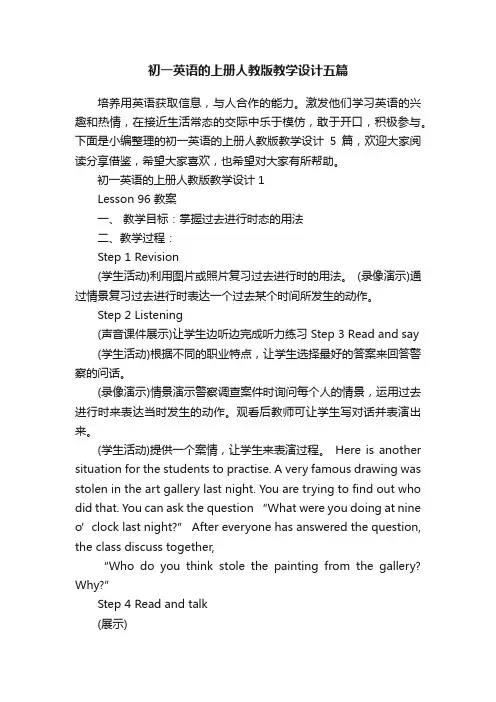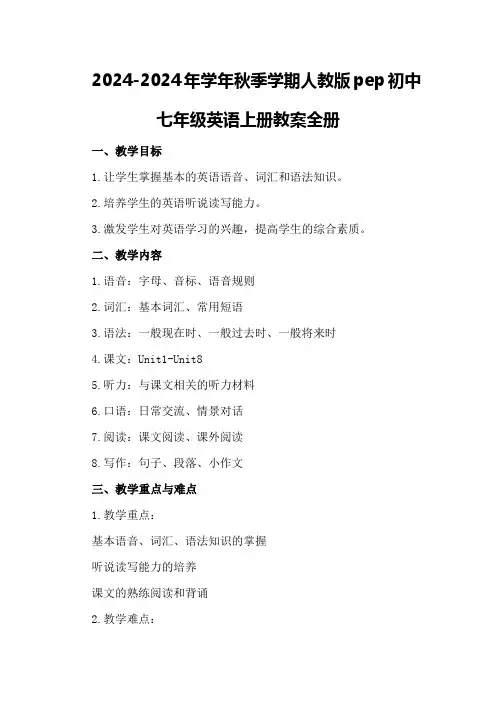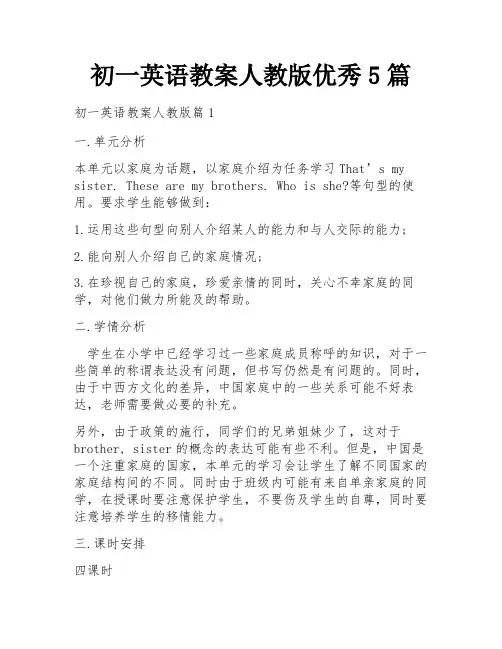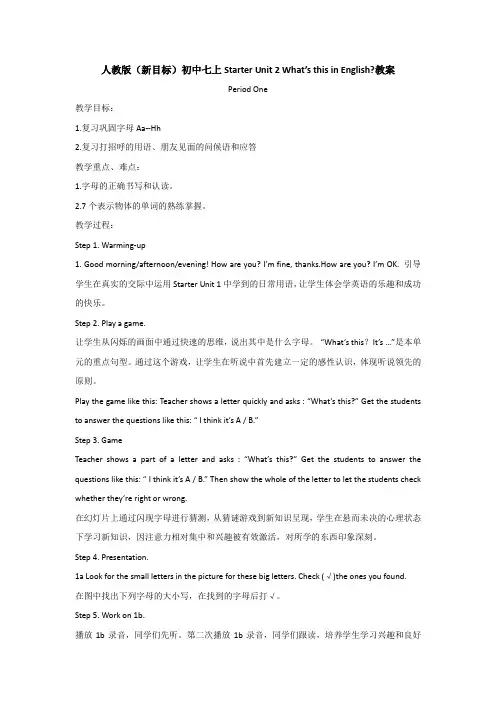初一英语人教版教案
人教版初一英语上册教案15篇

人教版初一英语上册教案15篇人教版初一英语上册教案【篇1】教学年级:七年级课程名称:Unit 3 Why do you like koalas?教材版本:人民教育出版社授课时间:40分钟(一)学生分析:1.本班学生对学习英语较感兴趣,能积极参加各种调查、采访、表演等实践活动。
2.学生学习动机明确,学习态度积极主动,能主动与他人合作,相互帮助,共同完成学习任务,遇到问题敢于主动向老师和同学请教,能大胆用英语交流。
(二)教材分析:本课时的内容是义务教育课程标准实验教科书英语新目标“Go for it!”七年级的《Unit 3 Why do you like koalas?》第一课时,主要话题是学习动物名称,并讨论喜好某种动物的原因。
通过话题的讨论喜欢动物的原因,增强了动物名称的词汇量,还增强课堂学习趣味性。
(三)教学目标语言知识目标1.学习有关动物的名词:tiger elephant koala dolphin panda lion penguin giraffe2.学习并运用品质的.形容词:cute smart shy ugly clever beautiful friendly quiet lazy来描述动物.3.掌握下列句型Why do you like…?. Because they’re….使学生熟练表达喜好并陈述原因。
语言能力目标1.学生能熟练谈论自己喜爱的动物并给出理由。
2.学生的口语和书面表达能力得到提高。
3.培养学生主动参与语言实践活动的能力,在游戏和小组竞赛中培养学生乐于表达、勇于展示自我的能力,从而树立学习英语的信心,获取成功的喜悦。
情感目标1.通过学习要培养学生自觉保护动物的意识。
2.培养学生积极参与,发扬团队合作的精神和竞争意识。
(四)教学策略1、教学方法Task-based, Language Teaching,途径:Guesing game, group work, pair work, survey, Internet teaching.2、教学辅助手段采用多媒体电脑投影图片,充分利用网络教材资源,扩大学生的知识面,激发学生的兴趣和求知欲。
初一英语的上册人教版教学设计五篇

初一英语的上册人教版教学设计五篇培养用英语获取信息,与人合作的能力。
激发他们学习英语的兴趣和热情,在接近生活常态的交际中乐于模仿,敢于开口,积极参与。
下面是小编整理的初一英语的上册人教版教学设计5篇,欢迎大家阅读分享借鉴,希望大家喜欢,也希望对大家有所帮助。
初一英语的上册人教版教学设计1Lesson 96 教案一、教学目标:掌握过去进行时态的用法二、教学过程:Step 1 Revision(学生活动)利用图片或照片复习过去进行时的用法。
(录像演示)通过情景复习过去进行时表达一个过去某个时间所发生的动作。
Step 2 Listening(声音课件展示)让学生边听边完成听力练习 Step 3 Read and say (学生活动)根据不同的职业特点,让学生选择最好的答案来回答警察的问话。
(录像演示)情景演示警察调查案件时询问每个人的情景,运用过去进行时来表达当时发生的动作。
观看后教师可让学生写对话并表演出来。
(学生活动)提供一个案情,让学生来表演过程。
Here is another situation for the students to practise. A very famous drawing was stolen in the art gallery last night. You are trying to find out who did that. You can ask the question “What were you doing at nine o’clock last night?” After everyo ne has answered the question, the class discuss together,“Who do you think stole the painting from the gallery? Why?”Step 4 Read and talk(展示)Read the table about what David was doing at different times yesterday, then ask and answer in pairs.(录像演示)情景演示询问过去某个时间点正在进行的动作,看后让学生进行模仿练习。
2024-2024年学年秋季学期人教版pep初中七年级英语上册教案全册

2024-2024年学年秋季学期人教版pep初中七年级英语上册教案全册一、教学目标1.让学生掌握基本的英语语音、词汇和语法知识。
2.培养学生的英语听说读写能力。
3.激发学生对英语学习的兴趣,提高学生的综合素质。
二、教学内容1.语音:字母、音标、语音规则2.词汇:基本词汇、常用短语3.语法:一般现在时、一般过去时、一般将来时4.课文:Unit1-Unit85.听力:与课文相关的听力材料6.口语:日常交流、情景对话7.阅读:课文阅读、课外阅读8.写作:句子、段落、小作文三、教学重点与难点1.教学重点:基本语音、词汇、语法知识的掌握听说读写能力的培养课文的熟练阅读和背诵2.教学难点:音标发音的准确性语法规则的灵活运用课外阅读的理解与分析四、教学进度安排1.第一周:Unit11.1Greetingsandintroductions 1.2Numbersandages1.3Colors2.第二周:Unit22.1Schoolsubjects2.2Classroomobjects2.3Dlyroutines3.第三周:Unit33.1Foodanddrink3.2Describingfood3.3Makingrequests4.第四周:Unit44.1Familymembers4.2Describingpeople4.3Talkingaboutfamily5.第五周:Unit55.1Time5.2Daysoftheweek5.3Activities6.第六周:Unit66.1Weather6.2Clothing6.3Describingtheweather7.第七周:Unit77.1Inthelibrary7.2Intheclassroom7.3Inthesupermarket8.第八周:Unit88.1Sports8.2Describingsports8.3Talkingaboutsports五、教学方法1.采用任务型教学法,让学生在实际语境中学习英语。
初一英语教案人教版优秀5篇

初一英语教案人教版优秀5篇初一英语教案人教版篇1一.单元分析本单元以家庭为话题,以家庭介绍为任务学习That’s my sister. These are my brothers. Who is she?等句型的使用。
要求学生能够做到:1.运用这些句型向别人介绍某人的能力和与人交际的能力;2.能向别人介绍自己的家庭情况;3.在珍视自己的家庭,珍爱亲情的同时,关心不幸家庭的同学,对他们做力所能及的帮助。
二.学情分析学生在小学中已经学习过一些家庭成员称呼的知识,对于一些简单的称谓表达没有问题,但书写仍然是有问题的。
同时,由于中西方文化的差异,中国家庭中的一些关系可能不好表达,老师需要做必要的补充。
另外,由于政策的施行,同学们的兄弟姐妹少了,这对于brother, sister的概念的表达可能有些不利。
但是,中国是一个注重家庭的国家,本单元的学习会让学生了解不同国家的家庭结构间的不同。
同时由于班级内可能有来自单亲家庭的同学,在授课时要注意保护学生,不要伤及学生的自尊,同时要注意培养学生的移情能力。
三.课时安排四课时四.教学过程Period 1 (A1, 3a, B3)I. Teaching Objectives1. Knowledge Objectives:(1) Expressions: sister, mother, father, parent, brother, grandmother, grandfather, grandparent, family, those, who, oh, these, those, they.(uncle, aunt, cousin, niece, nephew, here, photo )(2) Structure: That’s my family. Those are my parents. Who’s she? She’s my sister. Oh, and these are my brothers.3) Grammar: The plural forms of the demonstrative pronouns.2. Ability Objectives:(1) Learn how to introduce the family.(2) Get Ss to know the names of the various members ofa family.3. Moral Objectives: Father and mother, I love you!II. Teaching Importance(focus)(1) Learn how to introduce the family.(2) Get Ss to know the names of the various members ofa family.(3) Get Ss to know the differences between this/that is and these/those are.(4) Get Ss to know who questionsIII. Teaching Difficulties1. 因为单复数的问题,学生对this与these,that与those 的转换可能会弄错,2. 在拼写时,学生习惯把mother写成monther。
七年级上册英语教案人教版免费

七年级上册英语教案人教版免费(经典版)编制人:__________________审核人:__________________审批人:__________________编制单位:__________________编制时间:____年____月____日序言下载提示:该文档是本店铺精心编制而成的,希望大家下载后,能够帮助大家解决实际问题。
文档下载后可定制修改,请根据实际需要进行调整和使用,谢谢!并且,本店铺为大家提供各种类型的经典范文,如工作总结、述职报告、策划方案、演讲致辞、合同协议、条据文书、教案资料、好词好句、作文大全、其他范文等等,想了解不同范文格式和写法,敬请关注!Download tips: This document is carefully compiled by this editor. I hope that after you download it, it can help you solve practical problems. The document can be customized and modified after downloading, please adjust and use it according to actual needs, thank you!Moreover, our store provides various types of classic sample essays for everyone, such as work summaries, job reports, planning plans, speeches, contract agreements, doctrinal documents, lesson plans, good words and sentences, complete essays, and other sample essays. If you want to learn about different sample formats and writing methods, please pay attention!七年级上册英语教案人教版免费最新七年级上册英语教案人教版免费(8篇)作为一位不辞辛劳的人·民教师,通常会被要求编写教案,那么关于七年级上册英语教案怎么写呢?以下是本店铺准备的一些七年级上册英语教案人教版免费,仅供参考。
(完整版)人教版英语初中教案

人教版(新目标)初中七上Starter Unit 2 What’s this in English?教案Period One教学目标:1.复习巩固字母Aa--Hh2.复习打招呼的用语、朋友见面的问候语和应答教学重点、难点:1.字母的正确书写和认读。
2.7个表示物体的单词的熟练掌握。
教学过程:Step 1. Warming-up1. Good morning/afternoon/evening! How are you? I’m fine, thanks.How are you? I’m OK. 引导学生在真实的交际中运用Starter Unit 1中学到的日常用语,让学生体会学英语的乐趣和成功的快乐。
Step 2. Play a game.让学生从闪烁的画面中通过快速的思维,说出其中是什么字母。
“What’s this?It’s …”是本单元的重点句型。
通过这个游戏,让学生在听说中首先建立一定的感性认识,体现听说领先的原则。
Play the game like this: Teacher shows a letter quickly and asks : “What’s this?” Get the students to answer the questions like this: “ I think it’s A / B.”Step 3. GameTeacher shows a part of a letter and asks : “What’s this?” Get the students to answer the questions like this: “ I think it’s A / B.” Then show the whole of the letter to let the students check whether they’re right or wrong.在幻灯片上通过闪现字母进行猜测,从猜谜游戏到新知识呈现,学生在悬而未决的心理状态下学习新知识,因注意力相对集中和兴趣被有效激活,对所学的东西印象深刻。
七年级英语上册人教版全册教案
七年级英语上册人教版全册教案第一章:引言1.1 教学背景1.1.1 分析学生情况:针对七年级学生,英语学习处于基础阶段,需要引导学生逐步适应英语学习。
1.1.2 教材内容:人教版七年级英语上册,以话题为主线,培养学生的基本语言能力。
1.1.3 教学目标:激发学生学习兴趣,建立良好的学习习惯,为后续学习打下基础。
第二章:知识点讲解2.1 语音知识2.1.1 发音规则:介绍长元音、短元音、辅音等发音规则。
2.1.2 语音练习:通过听力练习,让学生辨别单词的正确发音。
2.1.3 语音应用:引导学生运用语音知识正确拼读单词和句子。
2.2 词汇知识2.2.1 单词构成:分析单词的词根、前缀、后缀等构成部分。
2.2.2 词汇练习:通过词汇游戏、练习册等途径,巩固单词记忆。
2.2.3 词汇应用:让学生在实际语境中运用词汇,提高运用能力。
2.3 语法知识2.3.1 基本句型:介绍主谓宾、主谓表等基本句型。
2.3.2 语法规则:讲解时态、语态、比较级、最高级等语法规则。
2.3.3 语法练习:通过填空、改错等形式的练习,巩固语法知识。
第三章:教学内容3.1 课本内容3.1.1 每课主题:根据课本内容,提炼每课的主题。
3.1.2 对话分析:分析对话内容,讲解重点词汇和句型。
3.1.3 课文理解:引导学生理解课文,提高阅读能力。
3.2 拓展内容3.2.1 相关话题:针对课本内容,拓展相关话题。
3.2.2 听力练习:选择合适的听力材料,提高学生听力水平。
3.2.3 口语表达:组织口语交流活动,提高学生口语表达能力。
第四章:教学目标4.1 知识目标4.1.1 掌握基本的语音、词汇和语法知识。
4.1.2 能够听懂、说出一日常用语。
4.1.3 理解课本内容,具备一定的阅读和写作能力。
4.2 能力目标4.2.1 提高学生的听、说、读、写四项基本技能。
4.2.2 培养学生的语言运用能力和团队协作能力。
4.2.3 培养学生的跨文化交际意识。
人教版七年级上册英语全英教案
人教版七年级上册英语全英教案教案是备课的展示与体现,至于采取何种形式还得根据七年级英语教师实际而定。
下面是小编为大家精心整理的人教版七年级上册英语的教案,仅供参考。
人教版七年级上册英语全英教案(一)Unit 3 This is my sister第一课时一、学习目标1、学会认知家庭成员,了解家庭关系。
2、学会介绍人,识别人。
3、通过认知家庭成员及关系学会使用指示代词复数these , those 的用法。
包括一般疑问句和否定句式。
4、能写一封书信。
5、能比较熟练的使用目标语言写一份介绍家庭成员或他人的短文。
二、学习内容三、朗读单词1. sister n. 姐;妹2. parent n. 父或母3. brother n. 兄;弟4. grandmother n. 祖母;外祖母5. grandfather n. 祖父;外祖父6. grandparent n. 祖父/ 母;外祖父/母7. these pron . & adj.这些8. those pron . & adj.那些9. she pron .她10. he’s =he is11. son n.儿子12. cousin n.堂(表)兄弟;堂(表)姐妹13. daughter n. 女儿14. uncle n.叔;伯;舅;姨父;姑夫15. aunt n. 姨母;姑母;伯母;婶母16. thank for为……而感谢17. here adv.在这里;向这里18. love v.爱;热爱19. much adv. 很;非常20. very much 很;非常21. soon adv.不久22. see you soon ,再见。
23. pen friend 笔友24. they pron. 他(她;它)们25. aren’t =are not四、任务示范Show the Ss some pictures , point at the pictures and tell them like this :This is my father / mother / brother / sister ……That’s my sister / grandmother / grandfather ……Then ask the Ss to bring their families’ pictures and introduce people in this way .五、布置作业1、请同学们反复朗读单词,并自查能记住多少单词。
人教版初一英语教案
人教版初一英语教案【篇一:人教版七年级上册英语全册教案】新目标英语(go for it)七年级上全册教案unit 1-12unit 1 my name’s ginaperiod one课前准备教师:准备游戏时所用的图片(食物、蔬菜、动物)。
学生:准备表演时所需道具(服装、假发)。
教学设计step one :present the sentence patterns.1. play a game “how many words do you know?”(利用小游戏调动学生的积极性,同时通过对冠军的介绍引出本课。
)teacher: after the study of the first three starters, i thinkmost of the students must have known a lot of words. how manywords do you know? let’s play a game to see who know? let’s play a game to see who knows the most.(divide all the students into several groups and show a picture (图片略) to them with the computer. every group can choose two students to join. they are asked to come to the blackboard and write down the words in 30 seconds.)(group 2 is the champion group. they can write 11 words.)2. introduce the champion group to the class.(引课方式贴近生活,学生易于接受)teacher: congratulations, now group 2 is the champion. but i don’t know your names. would you like to introduce y ourselves to us?s1 s2:yes.s1:hello.my name is li lei. nice to meet you.ss: hello, li lei. nice to meet you ,too.ss: hello! what’s your name?s2:i’m sun ping. how do you do?ss: how do you do ?step two: drills.1. make introductions.(通过句型的操练使学生更加熟练掌握所学的句式。
七年级上册英语教案人教版5篇
七年级上册英语教案人教版5篇最新七年级上册英语教案人教版5篇教案是教师教学过程中必不可少的指导工具,能够提升教学质量和效果。
下面是小编为大家整理的七年级上册英语教案人教版,如果大家喜欢可以分享给身边的朋友。
七年级上册英语教案人教版篇1Language goalIn this unit, students learn to talk about jobs.New languageWhat do you do I m a reporterWhat does he do. He s a student.What do you want to be I want to be an actor .What does she want to be She wants to be a police officernames of jobs and professionsSection ABrainstorm with students a list of jobs that friends or relatives do. ( Brainstorming is an activity in which you set a topic and students say whatever words they can think of relating to that topic.) Write the word jobs on the board and list all the jobs students mention.Point to the jobs one by one and ask students to say what ever they can about these jobs. Accept single word answers or simple sentences such as, It s fun. It s a good job.la This activity introduces the key vocabulary.Focus attention on the art. Ask students to tell what they see in each scene. Ask students to name as many of the jobs shown as theycan. Then point to a scene, name the job, and ask students to repeat. Point to the numbered list of words. Say each one and ask students to repeat.Then ask students to match each word wllfa one of the scenes. Say, Write the letter of each scene next to one of the ivords. Point tothe sample answer.1 b This activity gives students practice in understanding thetarget language in spoken conversation.Point to the different people shown in the picture.Ask various students to tell what they do as you point to each one,Say, Now you will hear three conversations. The conversations are about three of the people in this picture.Play the recording the first time. Students only listen.Play the recording a second time. This time ask students to write a number 1 next to the person being talked about in conversation 1. Have students put a 2 and 3 next to the people being talked about in conversations 2 and 3.Correct the answers.1 c This activity provides guided oral practice using the target language-Ask a student to read the example conversation with you. Hold upthe book and point to the doctor in the picture.Say, Now work with your partner. Make your own conversations about the picture. You can use sentences like the ones in activity 1b.Say a dialogue with a student. Point to a picture of one of the people. Guide the student to answer using one of the words inactivity 1a.As students work in pairs, move around the room monitoring theirwork. Oner language or pronunciation support as needed.2a This activity gives students practice in understanding thetarget language in spoken conversation.Ask students to look at the three pictures. Ask different students to tell you what they sec in each picture. What are the people doing What jobs do they havePlay the recording the first time. Students only listen.Say, You will hear conversations about the people in these pictures.Play the recording a second time. Say, Write the number of each conversation below the picture of the person being talked about.Correct the answers.2b This activity gives students practice in understanding thetarget language in spoken conversation.Point to the three headings in the chart and read the headings to the class. Ask students, What does wants to be mean (It is not the Job the person lias now. It is the job the person wants in the future.)Play the recording the first time. Students only listen.Say, You wiU hear about the people in these pictures. You will hear the job they haw now and the job they want in the future.Play the recording a second time. This time ask students to fill in the blanks with the jobs the people have now and the ones they wantin the future. Point out the sample2c This activity provides guided oral practice using the target language.Point out the pictures in activity 2a. Ask who each person is. (They are Susan s brother. Anna s mother, and Tony s father.)Say, Now work with your partner. Ask and answer questions about thepictures. Ask, What does he or she do Then ask, What does he or she want to beSay a dialogue with a student. Point to Anna s mother and then to the example in the speech balloons. Practice the dialogue with a student.As students work In pairs, move around the room monitoring their work. Offer language support as needed.3a This activity introduces the names for the places where people work, and gives reading practice using the target language.Call attention to the pictures. Ask students to read the name for each place. As they name each place, write the word on the board and-ask the class to repeat it.Point out the list of jobs with the numbers next to each. Then call attention to the people in the pictures and the speech bubbles. Point out the sample answer and have a student read out the speech bubble. Ask students to work alone. Say, Write the number of each job in the square next to each workplace.Check the answers.3b This activity provides guided oral practice using the target language.Point out the pictures in activity 3a. Ask students to name the workplace shown In each picture.Then point out the conversation in the speech bubbles. Ask two students to read It to the class.Say, Wow work with a partner. First practice the conversation in the picture. Then make new conversations. Use jobs and places from activity 3a.Say a dialogue with a student. Point to the word waiter in activity3a and then to the picture of the restaurant. Ask a student. Where does he work Guide the student to answer using the correct place: He works in a restaurant.Then ask. What does he do and guide the student to answer, He s a waiter.As students work in pairs, move around the room monitoring their work. Offer language support as needed.4 This activity provides listening and speaking practice using the target language.Call attention to the pictures in the book showing how to play the game. Say, You will draw a picture of someone working. Other students will ask questions about the kind of job you are drawing. After two questions someone can try to guess the job.Demonstrate by drawing a picture on the board of a stick figure reporter. Add details (microphone, notebook,etc.) until students guess what job it is.Ask a student to go to the board. Say, Draw a picture of a person working. If necessary, help the student add details that show the job the person is doing. He or she can add a bank interior to show that the person is a bank clerk. A student could also use an eye chart on the wall to show that the place is a doctor s office and the personis a doctor.Ask two different students to ask questions about the Job, and then ask a third student to guess what job it is.Play the game using drawings by several different students.Alternative: If you do not want students to move from their seats, then you can ask them to do this activity sitting down in groups of four. They will need pieces of paper on which to draw their pictures. They will also need pencils.Section BNew languageWords that describe jobs, such as exciting, dangerous,boring, difficult, busy, funAdditional materials to bring to class:help wanted ads from an English-language newspaper1 a This activity introduces the key vocabulary.Focus attention on the six pictures. Ask, What job does the person have Where does the person ivnrkPoint out the numbered list of words. Say each one and ask students to repeat. Then use simple explanations and short sample sentences to help students understand what each word means. For example, Exciting means very interesting and very fast-moving. A police officer has an exciting job. The job is always changing. Something is always happening. For dangerous you might say, Dangerous means not safe. You might be hurt or killed in a dangerous job.Then ask students to match each word with one of the pictures. Say, Write the letter of each picture next to one of the words. Point out the sample answer.Check the answers.1 b This activity provides guided oral practice using the target language.Call attention to the picture In this activity and ask a student to read the statement to the class. Then point to the picture of the police officer and say. It s an exciting job. Ask the class to repeat. Then say, What else can you say about being a police officer Someone may answer, It s a dangerous job. Ask the class to repeat each correct answer.Then ask students to work in pairs. Suggest that they each point to the pictures of the workers and make statements about them. As students practice, move around the classroom monitoring their work.1 c This activity provides an opportunity for oral practice.Say, Name some of the jobs from this unit. Write this list of jobs on the board. Say, Can you name some other jobs Add any new jobs to the list.Ask some students to make statements about Jobs on the list using the words in activity la. You may wish to write some of the sentences on the board so that students can copy the sentences into their notebooks.2a This activity provides listening and writing practice with the target language.Call attention to the two headings and ask a student to read die headings to the class.Point out the blank lines where students will write the name of a job (under the words wants to be).Play Ihe recording the first time. Students only listen.Say, Now I will play the tape again. This time write the name of a job under the words wants to be.2b This activity provides listening and writing practice with the target language,Call attention to the second heading and ask a student to read it to the class. Say, This time you will unite why each person wants the job.Play the recording again. Students only listen.Then say, Now I will play the tape again. This time write the reason the person wants the job under the word WhyPlay the recording. Students write their answers.Check the answers.2C This activity provides open-ended oral practice using the target language.Say, What do you want to be What words describe each job Help the class make up a list of jobs they might like to do. As students suggest possible jobs, ask the class to suggest words to describe them. Use a bilingual dictionary, if necessary, to find the names of jobs and words to describe each one.Then ask students to work in small groups. They tell each otherwhat they want to do and why. Encourage students to use dictionariesif necessary. Move from group to group offering assistance as needed. Ask individual students to tell the class about what they want tobe and why.3a This activity provides reading and writing practice using the target language.Call attention to the three newspaper ads and read these ads to the class. Say blank each time you come to a blank line.Then read each ad again separately, pausing to allow students toask questions about anything they don t understand. For example, in the first ad, students may not know that working late means workingat night. To work hard means to use a lot of energy to do the job.Ask students to fill In (he blanks in the ads using the words actor, reporter, and waiter.Check the answers.3b This activity provides reading and writing practice using the target language.Call attention to the newspaper ad and ask a student to read it,saying blank for each blank line.Ask students to fill in the blanks using words from This section. Say,Look at the pictures next to each blank line. The pictures will help you guess the correct word.Suggest that they look at the names of jobs and the words that describe jobs in the first part of Section B.Check the answers,3c This activity provides writing practice using the targetlanguage.Point out the blank strip of newspaper where students can write their own ads.Ask one or two students, What are you going to write about Repeat each of the students sentences and ask the class to repeat the sentences after you. For example: Do ^OM want an interesting but dangerous job Do you want to meet new people We need a police officer.Call the Smithtown Police Station at 555-2323.Ask students to read their ads to a partner. Ask the pairs to correct each other s work.4 This activity provides guided oral practice using thetarget language.Ask two students to read the conversation in the speech bubbles. Answer any questions students may have about it.Then say, New please work in groups. Ask efuestions to find out what jobs each person wrote about. You can use sentences like the ones we just read.As students ask questions, move from group to group. Rephrase any incomplete or incorrect questions.Also rephrase any inaccurate answers.七年级上册英语教案人教版篇2Unit 3 Language in use课型 Revision and application教材分析 Unit 3 对“自我介绍和获取信息”的功能句式进行综合训练:谈论自己或朋友的情况(活动1);根据提示完成介绍图片中人物情况的句子;填表、匹配复习表示国家、民族及人物活动的词汇。
- 1、下载文档前请自行甄别文档内容的完整性,平台不提供额外的编辑、内容补充、找答案等附加服务。
- 2、"仅部分预览"的文档,不可在线预览部分如存在完整性等问题,可反馈申请退款(可完整预览的文档不适用该条件!)。
- 3、如文档侵犯您的权益,请联系客服反馈,我们会尽快为您处理(人工客服工作时间:9:00-18:30)。
初一英语人教版教案【篇一:初一英语上册教案】人教版七年级英语(上册)辅导材料第一块国际音标国际音标是一种工具,其作用是标记英语字母和单词的读音。
1、20个元音单元音:/i/ it /?/about /u/ book// us // off /e/ at双元音:// ii // out//ear// aa,// oo//air// boy //sure2、28辅音:成对的清浊辅音:// fish// watch /tr / tree /ts/ its// usually// orange /dr/ dress /dz/ beds 其他辅音:/m/ am /n/ and // english /l/ like/h/ hello/r/ red /w/ what/j/ yes3、国际音标拼读规则:辅见元,碰一碰。
/l/在前,发本音;音节后面卷下舌。
/p/、/t/、/k/、/tr /清辅音,/s/后读成浊辅音。
本块词汇:speak说讲start开始 school学校 strict严格的 out外面 club俱乐部 usually通常 dress化妆 about关于大约 us我们 her她的ear耳朵 english英语 sure当然可以 air空气 or或者any一些boy男孩 orange橙子,桔子 map地图 tree树math数学off离开watch观看手表do做 like喜欢 beds床 what什么 hello喂是的red红色的yes是的 book书 its它的 zoo动物园fish鱼 dad爸爸 big大的have有 this这it它第二块三个预备单元一、文化常识1、英语文化区域,熟人之间见面,常要互相问好。
早上用语good morning !下午用语good afternoon ! 晚上用语good evening ! 例如:(1)bob: good morning , helen !helen : good morning , bob !(2)bob :good afternoon , helen !helen : good afternoon , bob ! ( 注意句子标点)(3)bob :good evening , helen !helen : good evening , bob !2、在轻松场合中,人们常用hello 或者hi 打招呼,但是两人用语要一致,不能一个人用hello,另一个人用hi 。
例如:(1) helen : hi , bob !bob : hi , helen !(2) helen : hello , bob !bob : hello , helen !二、几个功能句型1、问答“身体健康”用语bob : hi , helen ! how are you ? 喂,海伦!你好吗?helen : hi , bob != i’m ok ↘对方关心你的健康,↘你也要询问对方的健康。
可= i’m well 一定要向对方说谢谢。
以用简略语言:and you ?bob : i’m fine , too . 我也很好。
2、2、问一个东西“英语名字”的常用句型helen : what’s in english ? 这个用英语怎么说?↘(答句中,一定用it 代替this / that)bob : it’s a / an + 英语名称。
( key jachet quilt orange ruler pen )helen : spell it , please . ( = how do you spell it ? ) 请拼写它。
(= 你怎样拼写它?)bob : k- e-y . (拼写单词,用大写字母,并且字母和字母之间用连字符连接)3、问一个东西颜色的常用句型:helen :what color is it ?bob : it is + 颜色。
三、1、不定冠词 a 和 an 的区别a用在辅音开头的单词前,an用在元音开头的单词前。
例如a pen 一支钢笔;an apple 一个苹果a book 一本书 an hour 一小时a “u” 一个字母“u”an orange一个橙子;;2、指示代词 this 和 that 的区别this 指代近处的人或物,that指代远处的人或物。
本块习题:1、写出同义词或同义句hello !_________ i’m fine . __________ thanks . _________spell it , please ._______________________2、写出下列词的缩略形式 i am ______ what is ________ it is _________3、补全对话(1)、a: hi , helen ! how are you ?b : _______ , bob ! ______ ______ well , ______ ______ . _____________ ?a: i’m ______ , _______ .(2) 、a: what’s this _______english ?b : _______ is ______ jachet .(3)、 a : what ______ is it ? b : it______ green .4、改错(1)、---what is it ? ---it is an ―u‖ .(2)、---what’s that in english ?---that is a quilt .(3)、---what’s this in english ?---this is a key .(4)、this is an ruler , that is a orange .本块词汇:map 地图 key钥匙jacket 夹克衫 quilt被子orange橙子 ruler尺子 pen 钢笔 color颜色red红色的 yellow黄色的 green绿色的 blue蓝色的black黑色的 white白色的this这个 that那个spell拼写 apple苹果 hour小时unit 1my name’s gina一、what is , 缩略式what’s , 表示“是什么”。
问“某人的名字是什么”、“某人的姓是什么”、“某人的电话号码是什么”,都用what is 。
1、问某人的名字句型问句: what’s your name ?答句:my name’s + 名字。
his hisher her2、问某人的姓句型问句: what’ ?答句:family name’s + 名字。
his= last namehisher her3、问某人的姓的句型问句: what’s your first name ?答句:my first name’s + 名字。
his hisher her4、问某人电话号码的句型问句: what’s your telephone number ?答句:it is + 电话号码。
hisher5、nice to meet you ! ( 见到你真高兴!) 是“陌生人”见面客套用语。
对方答语只能是 nice to meet you , too . ( 见到你也真高兴)nice to see you ! (见到你真高兴!) 是“熟人”见面客套用语。
对方答语只能是 nice to see you , too . ( 见到你也真高兴)二、文化常识:英语人名(1)、英语人名由三部分组成:第一个名字 +第二个名字+ 姓。
first name middle name family name = last name(2)、英语人名最突出的特点是:名在前,姓在后,第二个名字不常说。
例如:1.ginagreen 吉娜 . 格林first name family name = last name2. first name family name = last name(3)、尊敬、客气地称呼一个人,常用方式是:mr 或 mrs 或miss + 姓。
gina green 我们可以称呼为 miss green 。
jim smith可以称呼为mr green三、形容词性物主代词表示“某人的”、修饰名词的代词叫形容词物主代词。
主格人称代词 i you hesheit we you they 汉语我你他她它我们你们他们形容词物主代词 my yourhisheritsour your their 汉语我的你的他的她的它的我们的你们的他们的本块习题1、name is (缩略式)_______boy (对应词)_______last name (同义词)_______ telephone number (同义词)_______my (主格人称代词)_______ you (形容词性物主代词)_______2、补全句子a:_________________b: my name’s mary .a:what’s his name ? b: _____________jim .a:_________________? b: my telephone number is 3968.3.根据括号中的答案,用完整句子回答问题。
1.what’s your name ? ( mary )_______________________2.what’s his name ? ( jim )_______________________3.what’s his last name ( green )?_______________________4.what’s her phone number( 92931 ) ?_______________________本块词汇:my我的 your你的 his他的 her 她的 its 它的our我们的 their 他们的 meet 遇见 see看见 we 我们 they 他们 zero 零 one 一two二 three 三 four四 five 五 six六 seven七 eight 八 nine九ten 十first name 名字 middle name 中间名字 nice好的高兴的telephone number = phone number电话号码family name = last name 姓【篇二:人教版七年级上册英语全册教案_(1)】新目标七年级英语上册教学计划一、学生情况分析及对策本学期担任的英语课,绝大多数学生入校前已学过英语或接触过英语,他们已经认识了部分字母和单词,掌握了英语学习的一些基本方法,但多数同学只是会说部分单词和句子。
